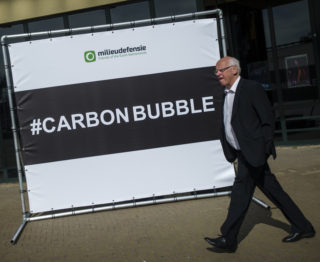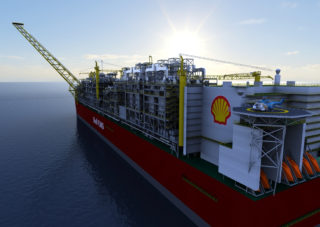Shell’s investment plans undermine climate goals

Shell says that it takes climate change seriously, but fossil fuel energy remains the company’s main priority. Its investments in fossil fuels are incompatible with the goals of the Paris Climate Agreement. If you don’t look too closely, Shell appears to be a leader in the fight against climate change. Shell’s 2015 Sustainability Report states, ‘We all must work together to achieve the goals of the Paris Agreement’. Recently, Shell Netherlands CEO Marjan van Loon called for a master plan for the energy transition, stating, ‘Our energy system and all that it has to do with in the economy is going to change dramatically’. And a year ago, Shell’s New Energies head Maarten Wetselaar told analysts that Shell is ‘determined to be a winning company in the energy transition’. Last but not least: by the end of this decade, Shell plans to invest 1 billion dollars annually in renewable energy.

Nevertheless, there are many indications that this is nothing more than rhetoric. In its most recent Sustainability Report (2016), Shell makes clear where its priorities for growth lie: deep sea oil and gas, and chemical products. According to Shell, these will be the future ‘cash engines’ of the company, starting in 2020. Shell has great expectations in this period for shale (oil and gas from shale formations, whose climate benefits when compared to coal are dubious, due to methane leakage), natural gas and new energies.
These priorities are reflected in recent mega-investments:
2011: Shell built the world’s largest floating natural gas processing plant, the Prelude, to extract natural gas from the seafloor and liquefy it instantly so that tankers can load it at sea. Shell wants to build many more floating platforms to make gas production possible in places that were previously inaccessible. Cost of the first model: between 10 and 13 billion dollars.
2015: Shell acquired BG Group for over 64 billion euros, the largest purchase ever made by a Dutch company. BG Group’s business is exploration and drilling for gas and oil. The company is one of the world’s largest operators in LNG, liquefied natural gas. Shell views LNG as a relatively clean fuel for the transition from fossil fuels to the renewable energy era. But an analysis by Down to Earth [Milieudefensie’s bimonthly magazine] revealed that to be a myth.
2016: Over the next five years, Shell is investing 10 billion dollars in Brazil, mainly for exploration and extraction of deep-sea oil.
2017: Between 2017 and 2020, Shell will be investing 1.2 billion dollars (300 million dollars per year) to expand its Argentine shale gas and oil drilling activities in Vaca Muerta, the largest shale oil and gas field in Argentina.
2017: Shell Australia has invested 50 billion dollars in LNG projects in the last five years.
The conclusion is that there simply is no room for Shell’s recent billions in gas and oil investments. These would increase the proven and probable global oil and gas reserves, and would ultimately contribute to further exceeding the carbon budget.
Compatible with Paris?
It is doubtful whether these investments can be reconciled with the goals of the Paris Agreement. This issue cannot be resolved at the company level only: if Shell’s competitors were to immediately halt their fossil fuel activities, that would just leave more room for Shell to make even greater investments in fossil fuel energy. It is however possible to calculate how much room ‘Paris’ offers for the oil and gas sector as a whole.
It was agreed in Paris at the end of 2015 that the average global temperature rise must remain well below 2 degrees Celsius. Efforts have focused on limiting the rise to 1.5 degrees. This ceiling gives climate scientists the chance to calculate the maximum amount of CO2 that can be emitted without exceeding the limits.
The size of the carbon budget has been calculated by the IPCC for the period after 2011. In the 2 degree scenario, this comes to 1000 Gton CO2 and in the 1.5 degree scenario it is 550 Gton. If we keep to this ‘budget’, there is a 66 per cent chance that we can remain under a temperature rise of less than 2 degrees, while for the 1.5 degree scenario, the chance is 50 per cent.
The US organisation Oil Change International (OCI) and a large number of NGOs worked this out further in the report, The Sky’s Limit. The report took 2016 as starting point for the remaining carbon budget, when the carbon budget calculated by the IPCC has already been partly used up. For the 2 degree scenario, 843 Gton still remains; for the 1.5 degree scenario, that is 393 Gton.
OCI compared this carbon budget with proven and probable global oil and gas reserves, plus proven coal reserves. A database from the authoritative Rystad Energy services was used for this calculation. Proven reserves have a 90 per cent chance of being extracted; for probable reserves the chance is 50 per cent.
The result was sobering: CO2 emissions from oil and gas fields that are now in production or under construction (locations where wells are completed or nearly completed, pipelines laid and the processing installations, transport modes and terminals have been completed), with CO2 emissions of 942 Gton, already exceed the 1.5 and 2 degree Paris goals by 100 Gton. The present level of production must thus be cut back and there is no room left for any new production.
Stranded assets
The conclusion is that there simply is no room for Shell’s recent billions in gas and oil investments. These would increase the proven and probable global oil and gas reserves, and would ultimately contribute to further exceeding the carbon budget.
Carbon Tracker Initiative (CTI) has calculated what the carbon budget means for the reserves of all the energy giants. CTI has figured that 77 billion euros of Shell’s investments are in so-called stranded assets: investments that are worthless if Shell takes the carbon budget (or in other words: the Paris Agreement) seriously. At the moment, this figure is probably lower, because Shell recently sold some of its assets (this was necessary to ease the large debt incurred by its acquisition of the BG Group). But CTI’s sobering conclusion is that all of Shell’s and the BG Group’s investments in LNG projects would be unusable in the 2 degree scenario.
Moreover, Shell’s investments increase the risk of what is referred to as carbon lock-in. New infrastructure construction for oil and gas has a horizon of approximately 40 years, and in the long term this would undermine achievement of the Paris climate goals.
Shell views it differently
Shell looks at it differently. In Shell’s opinion, the carbon budget has no consequences for the company’s activities. In 2014, Shell sent a letter to its shareholders, telling them they needn’t worry about stranded assets risks. Shell accepts that there is a large chance that the 2 degree limit will be exceeded.
In 2016, Shell published for the first time a company scenario in which the world would achieve the 2 degree climate agreement goal – A better life with a healthy planet: pathways to net-zero. But this scenario did not lead to a new investment strategy that is compatible with net-zero emissions. Shell wrote: ‘(…) we have no immediate plans to move to a net-zero emissions portfolio over our investment horizon of 10-20 years.’ Shell emphasised that the demand for oil and gas will continue to rise, due to the increasing global population. Shell’s analysis of the risks of possibly overvaluing its reserves is limited to oil fields that are already producing and projects that are nearly ready for production – it disregards investments in new reserves.
Time is running out for Shell. If Shell is to take climate issues seriously and exhibit real leadership, it has no choice but to make a complete reversal and move towards renewable energy, to stop investing in exploration to exploit fossil fuel reserves, and to write off its recent investments in deep-sea oil and gas and shales as losses.

